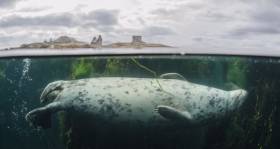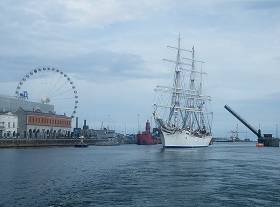Displaying items by tag: Dublin Port
#DiverConcerns - The Environmental Protection Agency (EPA) has been called upon by divers to withdraw a permit issued to Dublin Port which allows it to dump “dredge spoil” off Dublin Bay, writes The Irish Times.
The Irish Underwater Council said the permit approved by the EPA was issued before designation of a special area of conservation (SAC) in Dublin Bay extending from Rockabill to Dalkey Island.
Dublin Port wants to carry out maintenance dredging on its main shipping route in April and intends to use an existing EPA permit which it applied for in 2009.
The port’s “spoil site” is on the edge of the Burford Bank, and it stresses that all material in the navigation channel is either uncontaminated or “slightly/moderately” contaminated.
It points out that such maintenance dredging has been routine since the early 1880s and is intended to ensure ships do not run aground approaching or leaving the port.
However, the Irish Underwater Council and diver Peadar Farrell contend that the EPA permit was issued before designation of the Rockabill to Dalkey Island SAC.
The Burford Bank spoil site 5km southeast of Howth lies within the SAC, the diving organisation points out.
For further coverage of this story, click here.
Fuel From Russia As Belfast Namesake Tanker Docks in Dublin
#DieselDublin – An oil chemical products tanker loaded with diesel fuel from Russia, docked in Dublin Port yesterday following a week long delivery voyage, writes Jehan Ashmore.
The almost 30,000dwt Maersk Belfast took a northerly route via Scotland and through the North Channel off Belfast Lough, to where the Chinese built vessel (from the Guangzhou Shipyard) had previously made a maiden call to the city in 2010, some five years after her launch. To mark the occasion, Hamilton Shipping agency organized a presentation to the vessel's master.
On this current call to Dublin Port, Maersk Belfast was accompanied by sister tugs, Beaufort and Shackleton to assist the 175 metre long vessel to dock at Oil Berth No. 2. The diesel was discharged at the jetty facility from where the vessel is due to depart tonight.
The call of the Maersk Tankers A/S vessel is not new to Dublin Port, though what will be is next month’s Maersk Line (world’s largest container operator) new Europe-Med ‘feeder’ service as previously reported on Afloat.ie. The service will make direct calls to the Irish capital, a first ever for the Danish owned giant, the Maersk Group.
The new service to be operated by subsidiary Seago Line, will provide a direct service between Liverpool, Dublin and Spanish transhipment hub Algeciras. From the southern Iberian port that is west of Gibraltar, customers will be connected to markets in North Africa and the Mediterranean.
The Seago Line option will compliment Maersk Line’s existing calls to Cork and Rotterdam on the Latin American service launched in recent years.
Dublin’s East-Link Bridge to Be Renamed After a 1916 Leader
#1916bridge - Dublin’s East-Link Toll Bridge which celebrated its 30th anniversary a couple of years ago as reported on Afloat, is to be officially named the Tom Clarke Bridge in memory of the 1916 leader.
The Journal.ie writes that the toll bridge which is the last bridge over the Liffey before the river enters Dublin Bay and Dublin City Council say there are no records of it ever being officially named.
The bridge was built in 1984 under a deal between Dublin Corporation, Dublin Port and National Toll Roads. It passed into the control of Dublin City Council at the end of last year and is now to be named the Tom Clarke Bridge.
The proposal to name the bridge was put to councillors tonight after an application was made by Independent Councillor Nial Ring of the Commemorative Naming Committee.
For more on the renaming of the bascule bridge (click here) in which the 'lifting' span of 45 metres wide allows vessels to pass through to reach the city centre quays.
On the 30th anniversary of the bridge, the Naval Service OPV LÉ Aisling had the honour of making the transit of the raised bridge span that day. The span which weighs 500 tons was tilted to 80 degrees to allow LÉ Aisling to head upriver and berth.
'Starboard Home' Concert To Promote Dublin's Maritime Heritage
Dublin Port has announced details of Starboard Home, a unique collaboration featuring 12 of Ireland’s foremost songwriters. Presented in association with the National Concert Hall, Starboard Home has been commissioned by Dublin Port as part of the Ireland 2016 Centenary Programme. Twelve leading names in contemporary music have been invited to compose and perform new songs inspired by the relationship of the Port with the City.
Produced by acclaimed Irish songwriter Paul Noonan (Bell X1 and Printer Clips) and Gary Sheehan at the National Concert Hall, Starboard Home reflects on the complex relationships between the Port, the City and the Liffey through song, ranging from elegant electronic pop to sublime trad inspired moments and crafted song-writing. This remarkable set of songs presents a contemporary and panoramic view of Dublin as a port city.
Starboard Home features new works by Paul Noonan (BellX1 and Printer Clips), James Vincent McMorrow, Cathy Davey, Duke Special, Gemma Hayes, Jape, Colm Mac Con Iomaire, Lisa O’Neill, Declan O’Rourke, John Sheahan (The Dubliners), Paul Cleary (The Blades) and novelist Caitriona Lally.
Starboard Home will have its Premiere Concert at the National Concert Hall on 22nd June 2016 featuring Paul Noonan (BellX1 and Printer Clips), Cathy Davey, Duke Special, Gemma Hayes, Jape, Colm Mac Con Iomaire, Lisa O’Neill, Declan O’Rourke, John Sheahan (The Dubliners), Paul Cleary (The Blades) and novelist Caitriona Lally.
The artists gathered at Sun Studios in Dublin during February to collaborate and record Starboard Home. Bringing together a new band featuring Nick Seymour (Crowded House), Brian Crosby (formerly of BellX1 and The Cake Sale) and Glenn Keating (I Am The Cosmos and Jape), the artists have recorded all the new works for an album to be released in June 2016. Further details to be announced.
Advance tickets to the concert will be available to Friends of the National Concert Hall and a pre-sale window begins at 12.30pm on Monday 29th February with general sale on Wednesday 2nd March at 10am . To book go to www.nch.ie or call 01 4170000. Tickets: €27.50, €25.00, €22.50.
Starboard Home is supported by The Irish Independent and Today FM as print and radio media partners.
Commenting on the initiative, Eamonn O’Reilly, Chief Executive, Dublin Port said: “Dublin Port is delighted to announce that we have commissioned new contemporary music for 2016 from leading Irish artists in association with the National Concert Hall. Inspired by the Port and the Liffey, Starboard Home is a major addition to Ireland’s musical heritage which Dublin Port hopes will help rebuild the connection between the Port and the City which was so strong a century ago but which has waned in recent decades.
“Over the last three years, Dublin Port has looked to the arts to find a voice to help bridge the false dichotomy between Port and City and to remake the link of centuries. The Port’s support for culture and the arts builds on a long tradition of engagement with local communities in a way that engages new audiences.
“Where the languages of statistics, finance and commerce fail to convey the importance and relevance of Dublin Port, we have found that the arts succeed. We are confident that Starboard Home will help us to continue to communicate with the widest audience.”
Simon Taylor, CEO of the National Concert Hall, said: “As the home of music in Ireland and an iconic landmark in the city, the National Concert Hall is proud to partner with Dublin Port on their ambitious investment in commissioning and presenting this unique and exciting creative project. It represents a significant and imaginative contribution by Dublin Port to the Ireland 2016 Centenary Programme and continues the development of the National Concert Hall’s commitment and support of Irish musicians and composers across the musical spectrum.”
Starboard Home is the latest in a series of cultural and heritage initiatives by Dublin Port designed to present Dublin’s rich maritime heritage in new and thought-provoking ways.
Dublin Port’s recent initiatives encompass fine art, digital installation, modern sculpture and architectural revival:
· Dublin Port has created a modern interpretation for the Diving Bell on Sir John Rogerson’s Quay, part industrial heritage, part sculpture.
· Cliona Harmey’s Dublin Ships installation graced the Scherzer Bridge on North Wall Quay for nine months during 2015 intriguing passers-by with ever-changing couplets of ship names.
· Artist Feargal McCarthy created a replica installation of Dublin Port’s Northbank Lighthouse as part of the Science Gallery’s HOME\SICK 2015 exhibition with support from Dublin Port.
· The Port has more recently commissioned artist and NCAD graduate Eimear Murphy to create a new sculpture that will provide a focal point for Port Centre on East Wall Road, fashioned from contemporary materials which are the language of building and industry.
· Dublin Port is currently co-operating with Dublin City Gallery The Hugh Lane to bring an exhibition of the works of Antwerp’s port artist Eugeen van Mieghem to Dublin in 2017.
The Ireland 2016 Centenary Programme, led by Minister for Arts, Heritage and the Gaeltacht, Heather Humphreys, T.D., is a year-long programme of activity to commemorate the events of the 1916 Rising, to reflect on our achievements over the last 100 years and to look towards Ireland’s future. Full details of the Ireland 2016 Centenary Programme are available at www.ireland.ie.
Conflicting Interests on Dublin Port's Future Development
#Conflict -Dublin Port Company’s opposition to plans for housing on the Poolbeg peninsula, on the basis that at least some of the land may be required for essential port development, raises the fundamental issue of whether this area was ever really suitable for residential-led regeneration.
It is, after all, the location of major industrial installations, including the ESB’s Poolbeg power station, the municipal sewage treatment plant and the controversial waste incinerator, currently under construction. Would anyone want such potentially noxious facilities as neighbours?
There is already serious conflict between port operations and residents on Pigeon House Road, while proposals some years ago for an alternative purpose-built container port at Bremore in north Co Dublin came to nought. Dublin Port Company would have nothing to do with the plan as it had no intention of moving from its current location. For more The Irish Times has a report here.
Call to Conference – ESPO 2016 Dublin
#EPSO2016 – The European Sea Ports Organisation (ESPO) is to hold its annual conference in Dublin for the first time.
EPSO is inviting its members, policy makers and stakeholders to join the 13th edition of its annual conference
The conference (2-3 June) is being organised in co-operation with the Port of Dublin, Ireland’s premier port. Participants can register online.
The 2016 ESPO Conference will look into ways to improve the efficiency of maritime transport and ports, this from different angles: How to remove the remaining barriers in maritime transport and how to come to a real internal market for maritime transport? How to set the digital agenda for ports? Big data: what is in for European ports? How can ports benefit from new trade agreements? Are there potential game stoppers?
For decades now, the port and shipping industry have been calling for a “true” internal market for maritime transport, but which steps are needed? What is already there? Who or what are the real barriers? Since maritime policy is at the top of the 2017 Commission agenda, the ESPO conference aims at preparing the ground for this important year for the maritime and port sector and feeding further discussions.
If lifting the barriers of the internal market for maritime transport is essential to enhance the role of maritime transport and convert European ports into seamless gateways and nodes in the supply chain, it is not enough in itself.
Growing trade volumes and climate change policies will oblige ports and the whole logistic chain to make better use of the existing capacity in transport. The first way to address this challenge is digitalisation. Is there a digital agenda for ports? Is there a role for policy? The second way to optimise transport and port operations is to explore the world of “big data”. Information is power.
But how to use large quantities of data for the port’s benefit? Are we ready to open up the flow of data? How to protect against risks of cybercrime?
Moreover, the conference will investigate how TTIP, the trade agreement under negotiation with the US, could possibly benefit ports, on both sides of the Atlantic. At the eve of the British referendum an insight will also be provided on the possible impact of a “Brexit” for UK and European ports. Finally, the conference will zoom in on China’s “one belt, one road” concept and assess how this could affect the EU port industry.
As always the conference will close with a policy debate where EU High level policy makers will present their views on the issues discussed during the Conference and enter into a final debate with port authorities.
The conference is taking place on the premises of the Dublin Castle and always, the ESPO conference will combine high level debates with networking moments and dinners.
Cruise Europe Speakers Lining Up for Dublin Conference First
#CruiseEurope – Cruise Europe which has members from within northern and Atlantic Europe will be hosting the organisation’s annual conference in Dublin as previously reported on Afloat. This will be the first time the capital has hosted the major industry sector event.
More than 200 delegates from across Europe will gather for the Cruise Europe Conference between May 31 to June 2 at the Gibson Hotel located in the Point Village. The venue neighbours the port site to where a dedicated purpose built €30m cruise terminal, another first for Dublin was granted permission last year.
The double-cruise berth facility is part of the €230m Alexandra Basin Redevelopment project will be able to handle the world's top ten largest cruise liners, including the 360m long Allure of the Seas.
“We have a great line-up of speakers,” said Jens Skrede, managing director CE, who announced the participation of Miguel Reyna, director commercial development Royal Caribbean Cruises Ltd; Russell Daya, executive director global port operations & developments, itinerary and strategic planning Disney Cruise Line; and Clare Ward, senior commercial planning manager Fred Olsen Cruise Lines. Jens added that “more speakers will be announced later”.
Nigel Lingard will once again moderate the event and there will be plenty of time to network during the social events. After the AGM on Tuesday, there will be an open-top bus tour of the city which will end up at the Guinness Storehouse for a tour, informal dinner and entertainment like only the Irish know how.
The gala evening will take place after the main conference on Wednesday. It will be held at the stunning Royal Hospital Kilmainham which has been a place of caring since 1680.
Marine Notice: Emergency Cable Repair On Approach To Dublin Port
#MarineNotice - The latest Marine Notice from the Department of Transport, Tourism and Sport advises that Global Marine Systems Ltd has been contracted to undertake an emergency repair to the ESAT2 submarine fibre optic telecommunications cable in the Irish Sea within Irish Territorial Waters on the approach to Dublin Port.
The CS Wave Sentinel (Callsign MZBC8) is scheduled to arrive on site tomorrow (Monday 22 February) to commence works. The weather is currently being monitored and this timing could change depending on local conditions.
The repair works will last for approximately five days depending upon weather and other operational conditions.
The vessel will be limited in manoeuvrability and other vessels should give the vessel and its equipment, including cable buoys, a wide berth. It will be listening on VHF Channel 16 during the project.
Full details are included in Marine Notice No 6 of 2016, a PDF of which is available to read or download HERE.
Irish Cruising Comes Centre Stage In Howth Yacht Club
With last night’s Irish Cruising Club Annual General Meeting & Prize-Giving hosted at Howth Yacht Club, and this morning’s day-long ISA Cruising Conference at the same venue, centre stage has been taken by the silent majority – the large but distinctly reticent segment of the sailing population which emphatically does not have racing as its primary interest afloat. W M Nixon takes us on a guided tour.
The great Leif Eriksson would approve of some of the more adventurous members of the Irish Cruising Club. They seem to be obsessed with sailing to Greenland and cruising along its coast. And it was the doughty Viking’s father Erik Thorvaldsson (aka Erik the Red) who first told his fellow Icelanders that he’d given the name of Greenland to the enormous island he’d discovered far to the west of Iceland. He did so because he claimed much of it was so lush and fertile, with huge potential for rural and coastal development, that no other name would do.
Leif then followed in the family tradition of going completely over the top in naming newly-discovered real estate. He went even further west and discovered a foggy cold part of the American mainland which he promptly named Vinland, as he claimed the area was just one potential classic wine chateau after another, and hadn’t he brought back the vines to prove it?
In time, Erik’s enthusiasm for Greenland was seen as an early property scam. For no sooner had the Icelanders established a little settlement there around 1000 AD than a period of Arctic cooling began to set in, and by the mid-1300s there’d been a serious deterioration of the climate. What had been a Scandinavian population of maybe five thousands at its peak faded away, and gradually the Inuit people – originally from the American mainland – moved south from their first beachheads established to the northwest around 1200 AD. They proved more successful at adapting to what had become a Little Ice Age, while no Vikings were left.
Now we’re in the era of global warming, and there’s no doubt that Greenland is more accessible. But for those of us who think that cruising should be a matter of making yourself as comfortable as possible while your boats sails briskly across the sea in a temperate climate or perhaps even warmer for preference, the notion of devoting a summer to sailing to Greenland and taking on the challenge of its rugged iron coast, with ice everywhere, still takes a bit of getting used to.
Yet in recent years the Irish boats seem to have been tripping over each other up there. And for some true aficionados, the lure of the icy regions was in place long before the effects of global warming were visibly making it more accessible.
Peter Killen of Malahide, Commodore of the Irish Cruising Club, is a flag officer who leads by example. It was all of twenty years ago that he was first in Greenland with his Sigma 36 Black Pepper, and truly there was a lot of ice about. The weather was also dreadful, while Ireland was enjoying the best summer in years.

Peter Killen’s Sigma 36 Black Pepper in local ice at the quay inside Cape Farewell in Greenland, August 1995

ICC Commodore Peter Killen’s current boat is Pure Magic, an Amel Super Maramu seen here providing the backdrop for a fine penguin in Antarctica, December 2004.
More recently, he and his crew of longterm shipmates have been covering thousands of sea miles in the Amel Super Maramu 54 Pure Magic, among other ventures having a look at lots more ice down Antarctic way to see how it compares with the Arctic. With all their wanderings, by the end of the 2014 season Pure Magic was laid up for the winter in eastern Canada in Nova Scotia. So of course in order to get back to Ireland through 2015, the only way was with a long diversion up the west coast of Greenland. And the weather was grand, while Ireland definitely wasn’t enjoying the best summer in years.
The Pure Magic team certainly believe in enjoying their cruising, however rugged the terrain. If the Greenland Tourist Board are looking for a marketing manager, they could do no better than sign up the skipper of Pure Magic for the job. His entertaining log about cruising the region – featured in the usual impressive ICC Annual edited for the fourth time by Ed Wheeler – makes West Greenland seem a fun place with heaps of hospitality and friendly folk from one end to the other.

If ice is your thing, then this is the place to be – Peter Killen’s Pure Magic off the west Greenland coast, summer 2015.
But then Peter Killen is not as other men. I don’t mean he is some sort of alien being from the planet Zog. Or at least he isn’t so far as I know. But the fact is, he just doesn’t seem to feel the cold. I sailed with him on a raw Autumn day some years ago, and while the rest of us were piling on the layers, our skipper was as happy as Larry in a short-sleeved shirt.
I’d been thinking my memory had exaggerated this immunity to cold. But there sure enough in the latest ICC Annual is a photo of the crew of Pure Magic enjoying a visit to the little Katersugaasivik Museum in Nuuk, and the bould skipper is in what could well be the same skimpy outfit he was wearing when we sailed together all those years ago. As for the rest of the group, only tough nut Hugh Barry isn’t wearing a jacket of some sort – even Aqqala the Museum curator is wearing one.
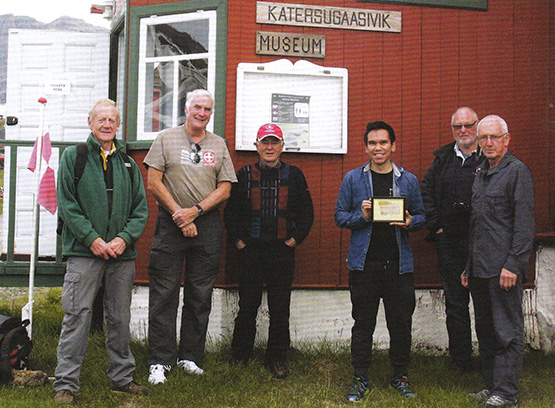
Some folk feel the cold more than others – Pure Magic’s crew absorbing local culture in Greenland are (left to right) Mike Alexander, Peter Killen, Hugh Barry, Aqqalu the museum curator, Robert Barker, and Joe Phelan
Having a skipper with this immunity to cold proved to be a Godsend before they left Greenland waters, when Pure Magic picked up a fishing net in her prop while motoring in a calm. Peter Killen has carried a wetsuit for emergencies for years, and finally it was used. He hauled it on, plunged in with breathing gear in action, and had the foul-up cleared in twenty minutes. Other skipper and Commodores please note……
The adjudicator for the 2015 logs was Hilary Keatinge, who has one of those choice-of-gender names which might confuse, so it’s good news to reveal that after 85 years, the ICC has had its first woman adjudicator. No better one for the job, man or woman. Before marrying the late Bill Keatinge, she was Hilary Roche, daughter of Terry Roche of Dun Laoghaire who cruised the entire coastline of Europe in a twenty year odyssey of successive summers, and his daughter has proven herself a formidable cruising person, a noted narrator of cruising experiences, and a successful writer of cruising guides and histories.
Nevertheless even she admitted last night that once all the material has arrived on the adjudicator’s screen, she finally appreciated the enormity of the task at hand, for the Irish Cruising Club just seems to go from strength to strength. Yet although it’s a club which limits itself to 550 members as anything beyond that would result in administrative overload and the lowering of standards, it ensures that the experience of its members benefit the entire sailing community through its regularly up-dated sailing directions for the entire coast of Ireland. And there’s overlap with the wider membership of the Cruising Association of Ireland, which will add extra talent to the expert lineup providing a host of information and guidance at today’s ISA Cruising Conference.
But that’s this morning’s work. Meanwhile last night’s dispensation of the silverware – some of which dates back to 1931 – revealed an extraordinarily active membership. And while they did have those hardy souls who ventured into icy regions, there were many others who went to places where the only ice within thousands of miles was in the nearest fridge, and instead of bare rocky mountains they cruised lush green coasts.
Nevertheless the ice men have it in terms of some of the top awards, as Hilary Keatinge has given the Atlantic Trophy for the best cruise with a passage of more than a thousand miles to the 4194 mile cruise of Peter Killen’s Pure Magic from Halifax to Nova Scotia to Howth, with those many diversions on the way, while the Strangford Cup for an alternative best cruise goes to Paddy Barry, who set forth from Poolbeg in the heart of Dublin Port, and by the time he’d returned he’d completed his “North Atlantic Crescent”, first to the Faeroes, then Iceland to port, then across the Denmark Strait to southeast Greenland for detailed cruising and mountaineering, then eventually towards Ireland but leaving Iceland to port, so they circumnavigated it in the midst of greater enterprises.
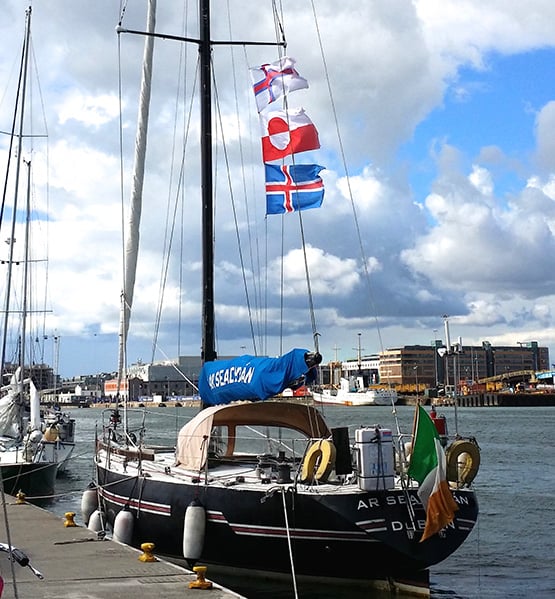
You collect very few courtesy ensigns in the frozen north. Back at Poolbeg in Dublin after her “North Atlantic Crescent” round Iceland and on to Greenland, Paddy Barry’s Ar Seachran sports the flags of the Faroes, Iceland and Greenland. Ar Seachran is a 1979 alloy-built Frers 45. Photo: Tony Brown
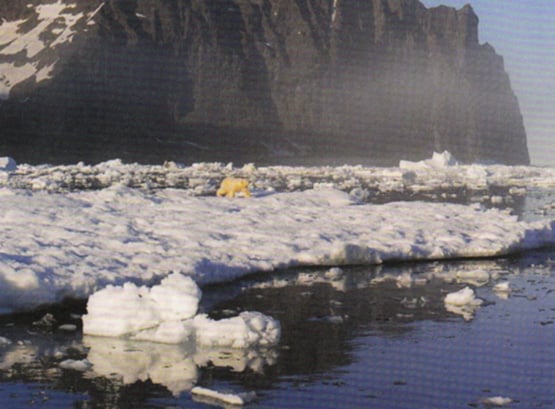
“Definitely the Arctic”. A polar bear spotted from Ar Seachran. Photo: Ronan O Caoimh
Paddy Barry started his epic ocean voyaging many years ago with the Galway Hooker St Patrick, but his cruising boat these days is very different, a classic Frers 45 offshore racer of 1979 vintage. Probably the last thing the Frers team were thinking when they turned out a whole range of these gorgeous performance boats thirty-five years ago was that their aluminium hulls would prove ideal for getting quickly to icy regions, and then coping with sea ice of all shapes and ices once they got there. But not only does Paddy Barry’s Ar Seacrhran do it with aplomb, so too does Jamie Young’s slightly larger sister, the Frers 49 Killary Flyer (ex Hesperia ex Noryema XI) from Connacht, whose later adventures in West Greenland featured recently in a TG4 documentary.
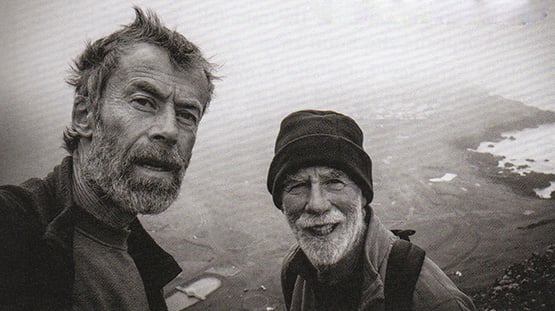
“A grand soft day in Iceland”. Harry Connolly and Paddy Barry setting out to take on mountains in Iceland during their award-winning cruise to Greenland. Photo: Harry Connolly
Pure Magic and Ar Seachran are hefty big boats, but the other ICC voyager rewarded last night by Hilary Keatinge for getting to Arctic waters did his cruise in the Lady Kate, a boat so ordinary you’d scarcely notice her were it not for the fact that she’s kept in exceptionally good trim.
Drive along in summer past the inner harbour at Dungarvan in West Waterford at low water, and you’ll inevitably be distracted by the number of locally-based bilge-keelers sitting serenely upright (more or less) on that famous Dungarvan mud. There amongst them might be the Moody 31 Lady Kate, for Dungarvan is her home port.
But she was away for quite a while last year, as Donal Walsh took her on an extraordinary cruise to the Arctic, going west of the British mainland then on via Orkney and Shetland to Norway whose coast goes on for ever until you reach the Artic Circle where the doughty Donal had a swim, as one does, and looked at a glacier or too, and then sailed home but this this time leaving the British mainland to starboard. A fabulous 3,500 mile eleven week cruise, he very deservedly was awarded the Fingal Cup for a venture the adjudicator reckons to be extra special – as she puts it, “you feel you’re part of the crew, though I don’t think I’d have done the Arctic Circle swim.”
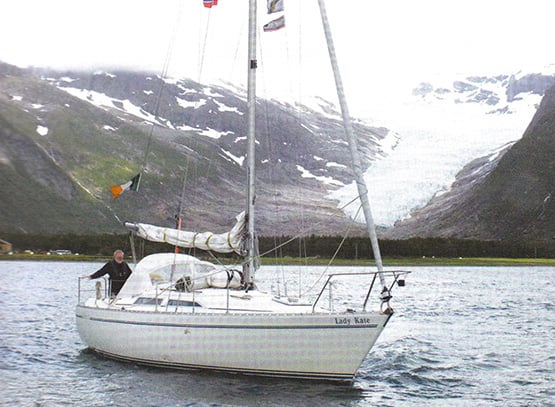
A long way from Dungarvan. Lady Kate with Donal Walsh off the Svartsen Glacier in northern Norway
Indeed, in taking an overview of the placings of the awards, you can reasonable conclude that the adjudicator reckons any civilized person can have enough of ice cruising, as she gives the ICC’s premier trophy, the Faulkner Cup, to a classic Atlantic triangle cruise to the Azores made from Dun Laoghaire by Alan Rountree with his van de Sadt-designed Legend 34 Tallulah, a boat of 1987 vintage which he completed himself (to a very high standard) from a hull made in Dublin by BJ Marine.
Tallulah looks as immaculate as ever, as we all saw at the Cruising Association of Ireland rally in Dublin’s River Liffey in September. And this is something of a special year for Alan Rountree, as completely independently of the Faulkner Cup award, the East Coast ICC members awarded their own area trophy, the Donegan Cup for longterm achievement, to Tallulah’s skipper. As one of those involved in the decision put it, basically he got the Donegan Trophy “for being Alan Rountree – what more can be said?”
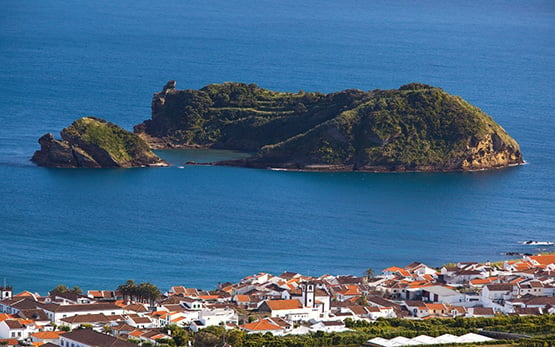
The essence of the Azores. Red roofs maybe, but not an iceberg in sight, and the green is even greener than Ireland. Alan Rountree’s succesful return cruise to the Azores has been awarded the ICC’s premier trophy, the Faulkner Cup.

Tallulah at the CAI Rally in the Liffey last Setpember. She looks as good today as when Alan Rountree completed her from a bare hull nearly thirty years ago. Photo: W M Nixon
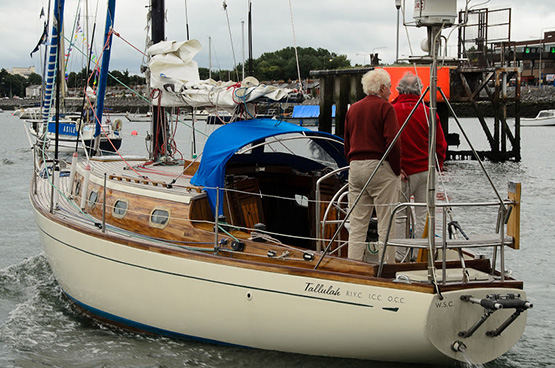
A boat to get you there – and back again. Tallulah takes her departure from the CAI Rally in Dublin. Photo: Aidan Coughlan
Well, it can be said that his Azores cruise was quietly courageous, for although the weather was fine in the islands, the nearer he got to Ireland the more unsettled it became, and he sailed with the recollection of Tallulah being rolled through 360 degrees as she crossed the Continental Shelf in a storm in 1991. But he simply plodded on through calm and storm, the job was done, and Tallulah is the latest recipient of a trophy which embodies the history of modern Irish cruising.
There were many other awards distributed last night, and for those who think that the ICC is all about enormous expensively-equipped boats, let it be recorded that the Marie Trophy for a best cruise in a boat under 30ft long went to Conor O’Byrne of Galway who sailed to the Hebrides with his Sadler 26 Calico Jack, while the Fortnight Cup was taken by a 32-footer, Harry Whelehan’s Jeanneau Sun Odyssey 32 for a fascinating cruise in detail round the Irish Sea, an area in which, the further east you get to coastlines known to very few Irish cruising men, then the bigger the tides become with very demanding challenges in the pilotage stales.
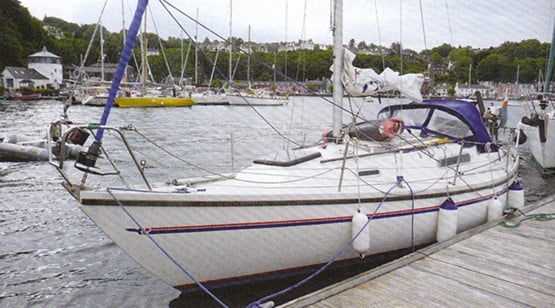
The smallest boat to be awarded a trophy at last night's Irish Cruising Club prize-giving was Conor O’Byrne’s Sadler 26 Calico Jack, seen here in Tobermory during her cruise from Connacht to the Hebrides
As for “expensively equipped”, the Rockabill Trophy for seamanship went to Paul Cooper, former Commodore of Clontarf Yacht & Boat Club and an ICC member for 32 years, who solved a series of very threatening problems with guts and ingenuity aboard someone else’s Spray replica during a 1500 mile voyage in the Caribbean, with very major problems being skillfully solved, as the judge observed, “without a cross word being spoken”.
Not surprisingly in view of the weather Ireland experienced for much of the season, there were no contenders for the Round Ireland cruise trophy, though I suppose you could argue that the return of Pure Magic meant the completion of a round Ireland venture, even if in this case the Emerald Isle becomes no more than a mark of the course.
In fact, with the unsettled weather conditions of recent summers in Ireland , there’s now quite a substantial group of ICC boats based out in Galicia in northwest Spain, where the mood of the coast and the weather “is like Ireland only better”. The ICC Annual gives us a glimpse of the activities of these exiles, and one of the most interesting photos in it is provided by Peter Haden of Ballyvaughan in County Clare, whose 36ft Westerly Seahawk Papageno has been based among the Galician rias for many years now.
Down there, the Irish cruising colony can even do a spot of racing provided it’s against interesting local tradtional boats, and Peter’s photo is of Dermod Lovett of Cork going flat out in his classic Salar 40 Lonehort against one of the local Dorna Xeiteras, which we’re told is the Galician equivalent of a Galway Bay gleoiteog. Whatever, neither boat in the photo is giving an inch.
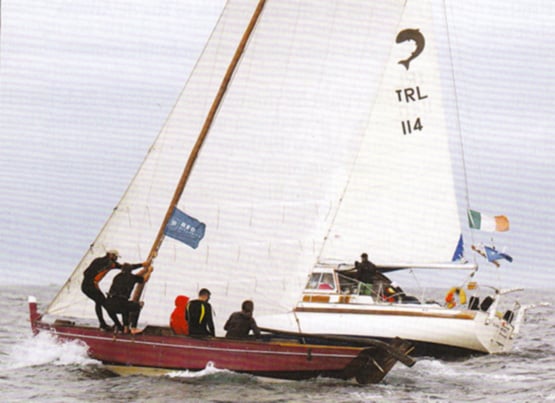
So who never races? Dermod Lovett ICC in competition with his Salar 40 Lonehort against a local traditional Dorna Xeiteira among the rias of northwest Spain. Photo: Peter Haden
Hilary Keatinge’s adjudication is a delight to read in itself, and last night after just about every sailing centre in Ireland was honoured with an ICC award for one of its locally-based members, naturally the crews leapt to the mainbrace and great was the splicing thereof.
But it’s back to porridge this morning in HYC and the serious work of the ISA Cruising Conference, where the range of topics is clearly of great interest, for the Conference was booked out within a very short time of being highlighted on the Afloat.ie website.
It’s during it that we’ll hear more about that intriguing little anchorage which provides our header photo, for although it could well be somewhere on the Algarve in Portugal, or even in the Ionian islands in Greece were it not for the evidence of tide, it is in fact on the Copper Coast of south Waterford, between Dungarvan and Dunmore East, and it’s known as Blind Harbour.
It’s a charming place if you’ve very settled weather, but it’s so small that you’d probably need to moor bow and stern if you were thinking to overnight, but that’s not really recommended anyway. Norman Kean, Editor of the Irish Cruising Club Sailing Directions, had heard about this intriguing little spot from Donal Walsh of Dungarvan (he who has just been awarded the Fingal Cup), and being Norman Kean, he and Geraldine just had to go and experience it for themselves. But it has taken three attempts to have the right conditions as they were sailing by, and it happened in 2015 in a very brief period of settled weather as they headed past in their recently-acquired Warrior 40 Coire Uisge, which has become the new flagship of the ICC’s informal survey flotilla.

The secret cove is to be found on Waterford’s Copper Coast, midway between Dungarvan and Dunmore East. Courtesy ICC
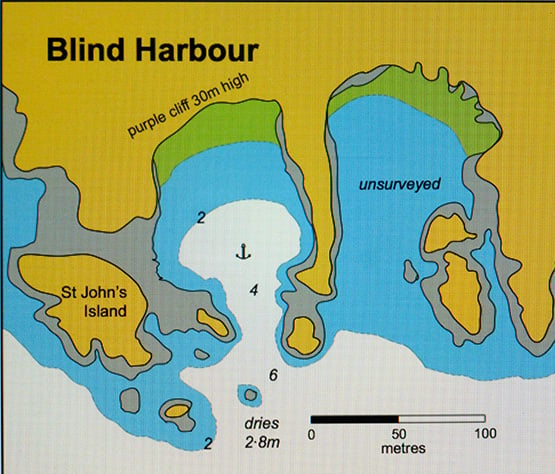
The newly-surveyed Blind Harbour on the Waterford coast as it appears in the latest edition of the ICC’s South & West Coasts Sailing Directions published this month. Courtesy ICC.
They found they’d to eye-ball their way in to this particular Blind Harbour (there are others so-named around the Irish coast) using the echo sounder, as any reliance on electronic chart assistance would have had them on the nearest part of County Waterford, albeit by only a matter of feet. With a similar exercise a couple of years ago, they found that the same thing was the case at the Joyce Sound Pass inside Slyne head in Connemara – rely in the chart plotter, and you’re making the pilotage into “impactive navigation”.
The message is that some parts of charts are still relying on surveys from a very long time ago, and locations of hyper-narrow channels may be a few metres away from where they actually are. On the other hand, electronic anomalies may arise. Whatever the reason, I know that a couple of years ago, in testing the ship’s gallant little chart plotter we headed for the tricky-enough Gillet passage inside the South Briggs at the south side of the entrance to Belfast Lough, and found that it indicated the rocks as shown were a tiny bit further north than we were seeing, which could have caused a but of a bump if we’d continued on our electronic way.
Electronic charts are only one of many topics which will be covered today. We hope to bring a full report next Saturday, for the participants will in turn require a day or two to digest their findings.
Five Detained After Jumping Out from Ferry Trailer at Dublin Port
#ferryillegal- Five men at Dublin Port who are believed to be illegal immigrants were detained on Monday.
Security officers for the port found the men after they got reports of the men leaving a secure compound from Irish Ferries.
“Five males were seen jumping out of a trailer coming out of the Epsilon, which arrived into Dublin from Cherbourg,” Thomas Kavanagh, security manager at Dublin Port said.
The Journal.ie has more on on the indicent involving the Epsilon, which saw extensive damage to vehicles during Storm Imogen last week.


























